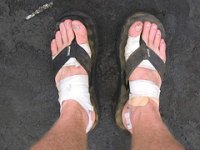
Blisters
Blisters are certainly the most common problem for HIKERS. Lack of conditioning and improper caring for your feet while hiking are the major cause of these avoidable pains. Blisters are caused by:
- Heat - generated from your foot rubbing against your sock which is being pressed by your boot.
- Moisture - softens the skin, resulting in less protection. It also reduces the ability of soft socks to smoothly slide on skin, causing more friction.
- Grit - sand, dirt, gravel in your boot will increase the friction in concentrated spots, generating more heat.
So, to prevent blisters, all you need to do is remove dirt, moisture, and heat from your feet. Keep your feet cool, dry, and clean. Following the Feet Conditioning and Feet Protection tips above will do that.
How to Treat Blister
- If the blister has not torn and is full of liquid, pierce it from the side with a sterile needle at its base. Let all the fluid run out.
- If the blister has torn already, carefully cut away the loose skin of the blister and treat the area with antiseptic.
- Allow the blister to dry and harden in the open air for as long as you can.
- When you need to resume hiking, put a bandaid or gauze over a torn blister.
- Put a layer of moleskin over the blister area. You may cut a doughnut shaped piece of moleskin that fits around the blister rather than directly on it.
- Check the blister at each stop and give it as much time to dry off as you can whenever you can. Keep it clean and sterilized to prevent infection.
- Do not pierce intact blisters that are deep, rather than just the top few layers of skin. Just apply a moleskin doughnut to relieve the friction and monitor the blister.
Reference:






 Karim Maalouf
Karim Maalouf
